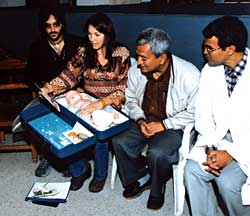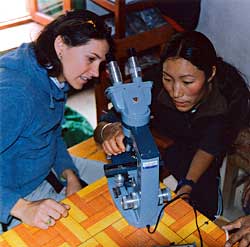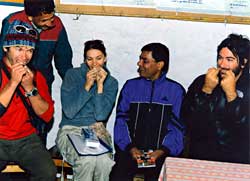 It was pure Hollywood: a call from Los Angeles, American rockstar Rami Jaffee of the Wallflowers on his way to Nepal and, if I was ready, a helicopter to whisk us to the Annapurnas. Very high profile, but that is how Janice Belson, founder of the non-profit group Medicines Global, and her team do it.
It was pure Hollywood: a call from Los Angeles, American rockstar Rami Jaffee of the Wallflowers on his way to Nepal and, if I was ready, a helicopter to whisk us to the Annapurnas. Very high profile, but that is how Janice Belson, founder of the non-profit group Medicines Global, and her team do it. For the past five years, Los Angeles-based Medicines for Nepal (GB) (the GB stands for 'give back') has organised one high profile trek a year to Nepal. Its goal is simple yet powerful: to make travellers aware that packing an extra first aid kit to drop off at health posts along the trails will keep them well stocked with medical supplies. All it takes is a few extra bandaids, a tube of antibacterial cream, some hydration salts and a little extra gauze. The idea is that individual travellers will supplement these annual drop-offs.
 The expeditions include leaders of the outdoor manufacturers such as Leki, The North Face, Mountain Hardwear, Lowe Alpine and Sierra Designs as well as big names from the entertainment world like Rami Jaffee and Carre Otis. "Keeping it high profile is important to garner public awareness," says Janice's daughter, Johanna Belson, who is director of expeditions. It's also an opportunity to create a delivery system of basic medical supplies to places that need them.
The expeditions include leaders of the outdoor manufacturers such as Leki, The North Face, Mountain Hardwear, Lowe Alpine and Sierra Designs as well as big names from the entertainment world like Rami Jaffee and Carre Otis. "Keeping it high profile is important to garner public awareness," says Janice's daughter, Johanna Belson, who is director of expeditions. It's also an opportunity to create a delivery system of basic medical supplies to places that need them. It began in 1992 when Belson came to Nepal on a two-month photography trek in the Sagarmatha region. Along the way she noticed many malnourished children, one of whom was blind because of Vitamin A deficiency. She also found most medicine cabinets in regional health posts sitting empty. Belson returned to the US wanting to give something back to Nepal. A couple of years later, it came to her: 'basic humanitarian first aid'. Explains Belson, "Everyone has the right to a bandaid, antibacterial cream or ibuprofen. It could prevent a simple cut from getting infected, sometimes severely."
In 1999, Belson returned to Nepal with a group that included her daughter Johanna, Usha Rai, the head of Newborn Medicine at UCLA hospital and Greg Wozer, general manager of Leki USA, which makes trekking and ski poles. The first delivery, worth $29,200, provided enough pharmaceutical Vitamin A for 3,000 children and medical supplies for Kanti Children's Hospital and several health posts.
Having a leader from an outdoor equipment supplier and a strong medical person on the team became the model for future expeditions. Last year, on their fifth expedition, Medicines for Nepal had an eight-member team that included Gregg Hedin, the head financial controller of sporting goods company Scott USA, and 27-year-old Zoe Robbins as the team nurse. They also had over $210,000 worth of medical supplies.
Our helicopter landed on to the rocky riverbed of the Kali Gandaki in the village of Larjung where the rest of the Medicines team had already arrived after drop offs at Jomsom Hospital and Namgyaling Tibetan Settlement outside Marpha. The team stopped at all the major health posts along the main trail. The next stop was Lete, a few hours hike south.
 We found that although infant mortality was lower here than the national average, dysentery, diarrhoea, worms, skin diseases and gastritis are the top five killers. Health Assistant Tulasi Prasad Bhatta tells us, "We don't charge for medicines but what the government assigns is inadequate." The Lete centre, with its neat cascade chart of staff names and designations and tidy rooms is far better off than the health post at Tatopani, which has a bed and a doctor's desk crammed into its single dingy room. But no matter what the appointments, one complaint is consistent: the government just doesn't send enough medicines.
We found that although infant mortality was lower here than the national average, dysentery, diarrhoea, worms, skin diseases and gastritis are the top five killers. Health Assistant Tulasi Prasad Bhatta tells us, "We don't charge for medicines but what the government assigns is inadequate." The Lete centre, with its neat cascade chart of staff names and designations and tidy rooms is far better off than the health post at Tatopani, which has a bed and a doctor's desk crammed into its single dingy room. But no matter what the appointments, one complaint is consistent: the government just doesn't send enough medicines. The numbers look good in Myagdi: there are 40 government health institutions for 120,000 people, including one district hospital in Beni, primary healthcare centres, health posts and sub health posts. It may make seem like a reasonable ratio considering the population, but the picture is bleak when we consider that the government spends only $3 annually per person on health.
Why the Annapurna region? Johanna Belson explains how the organisation hoped to primarily establish a proper distribution mechanism in an area where travellers are certain to go: "Even though the Annapurna is known to be better off than other areas, we found that our supplies were definitely needed." They're counting on these travellers returning to Nepal and going to more remote areas to make similar drop-offs.
Over the years, Medicines for Nepal has given supplies to the Maternity Hospital in Thapathali, Bir Hospital, TU Teaching Hospital, Siddhi Memorial Foundation in Bhaktapur and Tashi Palkhiel Tibetan Settlement in Pokhara. They have a long standing rapport with Kanti Children's Hospital where they are raising funds for Prakash Nidhi Tiwari to join a fellowship at Children's Hospital in Los Angeles, the world's leading facility for paediatric oncology. Tiwari will then return to develop Nepal's first paediatric cancer ward. Sponsors like the i2 Foundation, Operation USA who provide Vitamin A, Adventure Medical Kits who donate almost $10,000 in medical supplies every year and many others make the project successful. "We are most directly focused on Nepal. Our five successful deliveries to Nepal have an accumulated retail value of donated supplies that amount to $611,417," says 60-year-old Belson, whose group is now focusing this fall's expedition on raising funds and medical donations for Beni Hospital.
 The program has critics who question the holistic approach of the organisation and ask whether this kind of work actually does more harm than good. One strong voice against what he calls "medical tourism" is Stephen Bezruchka at the International Health Program at the University of Washington. His own experience in Nepal since his first visit in 1969, ten years of which he spent working as a medical tourist, has led Bezruchka to the conclusion that such projects detract from healthcare facilities already being developed in an area.
The program has critics who question the holistic approach of the organisation and ask whether this kind of work actually does more harm than good. One strong voice against what he calls "medical tourism" is Stephen Bezruchka at the International Health Program at the University of Washington. His own experience in Nepal since his first visit in 1969, ten years of which he spent working as a medical tourist, has led Bezruchka to the conclusion that such projects detract from healthcare facilities already being developed in an area. Local experts are also concerned about travellers distributing medicine. Buddha Basnyat, a specialist in high altitude medicine, understands what motivates people to bring medicines in, but he says,"They have a moral responsibility to make sure the medicines are properly used." This includes making certain the medicines reach trained personnel and that possible side effects are explained. There are other concerns that attractively packaged foreign medicines will compete with locally manufactured ones. But there is the counter-argument that Medicines for Nepal at least provides medicines where there aren't any, and has a regular channel to keep the supplies going to remote health posts. And for Nepalis that may just mean the difference between life and death.
Contact
Web: www.medicinesglobal.org
Email: [email protected]


